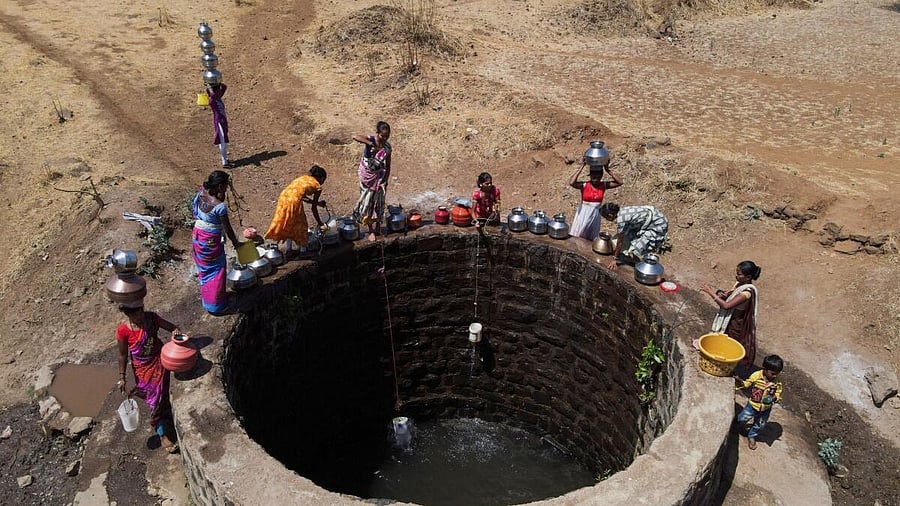
A drone view of women drawing water from a well on a hot day in Kasara
Credit: Reuters Photo
The hills have sweltered through three weeks of temperatures that broke all previous heat records. The cardamom flowers have crumbled. The buds of coffee, cocoa, and cloves have wilted away. There is no water in the borewells, and no signs of summer showers in the hill stations and high ranges of Idukki and Wayanad districts of Kerala.
The usually bustling tourist towns look abandoned this summer vacation, heat-stressed cows are yielding less milk, and poultry farmers are reporting high mortality of chicks as the mercury discovers new highs in the hills. Some parts of Kerala experienced temperatures that were 5.5 degrees Celsius above normal.
Four people have died of heatstroke and more than 400 people sought treatment for heat-related ailments according to the health department of Kerala. Under similar conditions in 2016, the state reported 324 sunburn cases and about 10 deaths.
As millions of people huddle indoors amid the region's dangerous heat waves, one thing is clear — adapting to a warmer world is different than surviving floods, fires, and cyclones.
Across India, 155 stations of the India Meteorological Department (IMD) reported maximum temperatures above 40 degrees Celsius, with numerous areas in Odisha and Andhra Pradesh experiencing temperatures exceeding 44 degrees Celsius. The IMD has predicted three times more heatwave days than usual between April and June due to the receding El Nino conditions, which are expected to become neutral by June.
The truth is that with or without El Nino, the current high temperatures are the new normal, and if we are not ready for the heat of today, we are definitely not ready for the heat tomorrow. The risk is only increasing.
About 172 heat wave days were recorded across India in 2022, a significant increase compared to the previous year. In the last two years, these events were more intense in India’s northern regions, coinciding with droughts and water shortages. Such events are set to get yet more frequent and severe due to climate change.
India’s National Action Plan on Heat Related Illness, published by the Union health ministry, states that ‘Climate change is expected to increase the heatwave frequency (HWF) and Heatwave duration (HWD) in India by 0.5 events per decade and 4-7 days per decade, respectively.”
For more than 6,000 years, the human race has learned to live within a relatively narrow band of environmental and climatic fluctuations. The mean annual temperature over that period has been around 13ºC. The crops, livestock, and irrigation that are the bedrock of the planet’s food production system were developed, discovered, and designed within those constraints. In their recently published paper, 'Future of the human climate niche', researchers warn that these, and other critical systems, cannot be expected to function normally outside the environmental niche they grew up in.
As temperatures continue to rise, these human-friendly conditions or niches could become scarce in many parts of the world. Since 1970, the Earth’s temperature has spiked faster than in any comparable 40-year period in recorded history. The eight years between 2015 and 2022 were the hottest on record, and 2023 broke that record too.
Globally, killer heat waves are becoming longer, hotter, and more frequent. With record-breaking heat year after year, temperatures were recorded in the high 40s and low 50 degree Celsius. For comparison, core human temperatures of 40 degree Celsius are categorised as fever, requiring medical attention. In extreme cases, permanent brain damage can occur, or even death.
Ironically, except for Kerala, there are no reports of heat wave-related deaths from other parts of India this year. India counts only those deaths medically certified as having been caused by direct exposure to the Sun as heat stroke deaths, thereby capturing only 10 per cent of the real figure.
According to a report published in 2021 by India’s National Disaster Management Authority, only four people died due to heatwaves in 2020. However, the National Crime Records Bureau (NCRB), which collects data on deaths from ‘forces of nature’, recorded 530 deaths from “heat/sun stroke” in the same year.
There is no logical explanation for this practice of under-reporting heatstroke deaths, unless it is to avoid the complications of providing compensation to heatstroke victims. It cannot be denial. Denial is dangerous. We know a lot more now about how much warming to expect, which makes it more possible to engineer a response.
In India, by the end of the century, there would be 30 times as many severe heat waves as today, according to one estimate, and 93 times as many people would be exposed there to dangerous heat. Accurate reporting of deaths by heatstroke is essential to create informed policies to build resilience. Adapting will require acknowledging, not fudging data. ‘Death by heatstroke’ is a reality we must accept.
(Shailendra Yashwant is a senior adviser to Climate Action Network South Asia (CANSA). X: @shaibaba.)
Disclaimer: The views expressed above are the author's own. They do not necessarily reflect the views of DH.